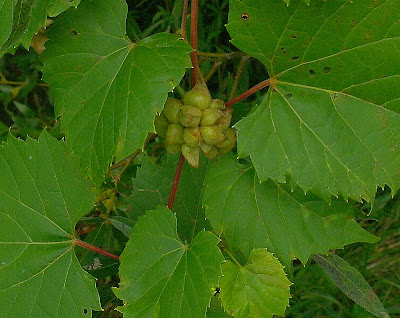On the Path -- August 20th, 2012
My favourite season is approaching. After a slow start, the signs are now coming fast & furious. I find summer to be a slow time in nature. With the changes that fall brings, things are happening again. And the cooler weather brings that invigorating feeling again, instead of the languishing feeling that accompanies summer's heat.
We can come out of our air-conditioned caves more often now, to enjoy nature at her fullest.
I take this shot a lot. The trees change but so does the light, so each shot is a little different from all the others. And then there's the choice of what exactly to include in the frame.
Queen Anne's Lace varies little from plant to plant in the summer, but come fall the variation is surprising. There are still quite a few in their summer dress but the "bird's nest" stage is evident in more & more of them each day. And the bird's nests vary considerably.
It's one of my favourite wildflowers in the fall, whereas in the summer I find it bordering on boring.
Some of the larger Poison Ivy plants have reached the berry stage.
Others have already taken on the reds of fall.
Tattered but standing proud, some Chicory and Bladder Campion.
The meadow at the top of the path has had a lackluster look all summer. It's still not very impressive but it's showing some colour.
Wild Grapes that don't look like grapes yet. They look more like large, green beech tree seeds.
An odd one I don't remember seeing before. The leaves along the stem are different to be sure.
"Just" leaves, but I think they're gorgeous!
Even the dreaded Dog-Strangling Vine has an attractive leaf.
Here, Dog-Strangling Vine is showing its invasive side, climbing over everything in sight, to over 10 ft off the ground.
Another of my favourites. Wild Cucumber has a unique leaf and its delicate blossoms add that special touch.
As it twists and winds its way through the forest, it often makes interesting shapes and patterns... in this case, a heart.

- The leaves were used in the past for diapers & toilet paper. Aren't we lucky to have stores nearby.
- Indians of North America lined their moccasins with the leaves to keep out the cold, and colonists used them in their stockings for the same reason.
- The tall stalks (to 8 ft) that develop in the 2nd year were dipped in melted fat and used as torches by Roman soldiers.
A few Red Clover are still poking up through the grasses et al.
I couldn't get a clear view of this cat but its colours were so beautiful that I took a shot anyway. We had a short staring match, then I left it in peace.
Brown-eyed Susans with some arching Raspberry canes.
There are only a few Field Bindweed on the path, and those that are there have to fight for some breathing room.
Shades of autumn...
I've been told there a five types of Goldenrod in Canada. This is it's time.
Some "Butter & Eggs" (Common Toadflax) sharing its space with some Goldenrod.
I like to examine things in detail. I took this Milkweed pod apart. The white blob at the bottom of the image is the "milk" that gives the plant its name. The "lattice" between the outer casing and the seeds is fascinating. The entire pod is fascinating. Nature really is incredible.
Plantain... with its "skinny fingers". It's found the world over.
I know that a lot of people shudder at the thought of summer fading into fall. Me, on the other hand... I look forward to it. I'm about to welcome my three favourite seasons. :-)
Labels: On the Path
































0 Comments:
Post a Comment
Subscribe to Post Comments [Atom]
<< Home